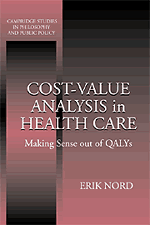Book contents
- Frontmatter
- Contents
- List of Tables and Figures
- Preface and Acknowledgments
- Overview
- Reader's Guide
- 1 Maximizing Value in Health Care
- 2 Three Basic Issues in Economic Evaluation
- 3 QALYs
- 4 Concerns for Fairness
- 5 The Limitations of Utility Measurement
- 6 Ways to Go
- Annex: An Example of Cost-Value Analysis
- References
- Index
2 - Three Basic Issues in Economic Evaluation
Published online by Cambridge University Press: 06 July 2010
- Frontmatter
- Contents
- List of Tables and Figures
- Preface and Acknowledgments
- Overview
- Reader's Guide
- 1 Maximizing Value in Health Care
- 2 Three Basic Issues in Economic Evaluation
- 3 QALYs
- 4 Concerns for Fairness
- 5 The Limitations of Utility Measurement
- 6 Ways to Go
- Annex: An Example of Cost-Value Analysis
- References
- Index
Summary
AT WHICH LEVELS OF DECISION MAY ECONOMIC EVALUATION BE HELPFUL?
There are, broadly speaking, three levels of decisions at which the goal of maximizing membership value may be pursued. One involves decisions that determine the capacity to admit patients with different conditions or the capacity to implement different preventive programs (including, e.g., screening programs). This is the budget level. Another consists of decisions regarding which individuals to admit to a service, given the capacity to treat which has been decided for that service. This is the admission level. A third comprises decisions about how to treat those individuals who are admitted. This is the bedside level. At each of these levels alternative courses of action may be judged in terms of costs and benefits. In other words, they are all decision levels that in principle lend themselves to economic analysis. On the other hand, the psychological circumstances surrounding resource allocation decisions vary considerably across these levels. Budget decisions concern people who are unknown to the decision makers (so called statistical patients). The decisions are made by many individuals together in a lengthy process in which there is room for careful analysis in a written form. By contrast, decisions at the bedside level are made by a single doctor or a small team of doctors who face their patients directly and often are quite pressed for time. Decisions at the admission level lie somewhere between these two extremes, particularly with respect to the degree of personal contact between patients and doctors. Given these varying circumstances, many will argue that formal economic analysis has a role to play primarily at the budget level of decision making.
- Type
- Chapter
- Information
- Cost-Value Analysis in Health CareMaking Sense out of QALYS, pp. 7 - 17Publisher: Cambridge University PressPrint publication year: 1999



